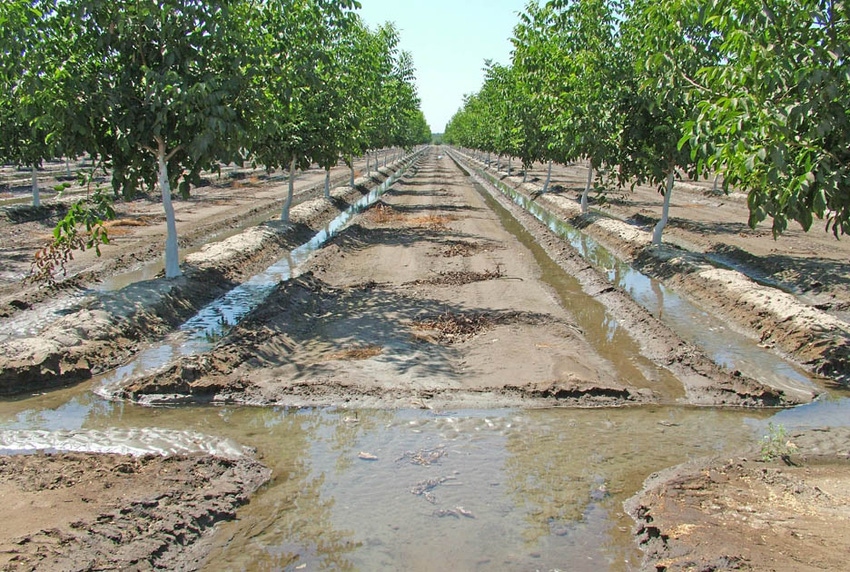
Walnut tree health, production, and crop quality are closely tied to irrigation management.
Bruce Lampinen, integrated orchard management walnut and almond specialist with the University of California, Davis, says delaying irrigation initiation in the spring may provide benefits in water savings, increased rooting depth, and improved tree health.
Lampinen has conducted research on deficit irrigation in walnuts, and examined delays in the initial irrigation, basing the decision on pressure chamber readings. The pressure chamber can also help growers avoid overwatering trees which if it occurs can have an adverse impact on tree health.
“There are strategies to save water and not impact crop returns,” Lampinen told growers during the Tri-County Walnut Day event held in Visalia, Calif.
Lampinen’s 2014-2016 irrigation research was conducted on nine-year-old Chandler/Paradox trees in Tehama County, Calif. He examined delays on initial irrigation based on the stem water potential from one to four bars below baseline gained from pressure chamber readings.
A grower-initiated start date was also used in the study. Lampinen studied the impact on yield, nut quality, and tree health.
Deciding when to start irrigation in the spring is one of the most valuable uses of the pressure chamber, Lampinen shared. Over the three-year study, he wanted to answer the question - will a later start date mean the trees will always be “behind?”
Over the three-year trial, start dates for initial irrigation ranged from April 28 (grower initiated) to June 16 (-4 bars) in 2014; from April 27 (grower initiated) to June 1 (-4 bars) in 2015; and from May 28 (grower initiated) to June 7 (-4 bars).
Lampinen’s yield data from the trial showed in most cases that plots with earlier irrigation starts had higher yields, nut weights from all three start dates were similar, and there was no significant differences in nut size or quality throughout the study.
Lampinen’s conclusion - pressure chamber use to decide when to start irrigating in the spring was beneficial, and allowing mid-day stem water potential to fall to 2 bars below baseline before initiating the water may lead to water savings over the growing season.
Later starts did not impact overall production.
Lampinen also noted that the grower participating in the trials was convinced that long-term tree health is improved with the -2 bar start. There were minimal impacts on crop yields with the delay.
Another part of Lampinen’s research focused on water use in trees which were pruned either minimally, a heavy prune, or left unpruned trees. He examined the water needed to support the canopy based on a proportion of 42 inches needed at 60 percent canopy. Ten inches of additional water was needed in minimally pruned trees compared to unpruned third leaf trees.
Not pruning, he say, can increase water use efficiency in years two through six by 20 percent to 25 percent.
In contrast to deficit- or pressure chamber-led irrigation, Lampinen says overwatering walnut trees can have serious impacts on tree growth, nut drop, and quality. Trees wetter than baseline tend to have more ‘June drop.’ Excessively wet trees tend to produce darker kernels.
Lampinen cited a trial with intentionally overwatered trees. Every rootstock and scion combination in the trial produced nuts with darker pellicles with lower relative value.
Leaf damage was also observed in overwatered trees. Tip burn, distorted leaf margins, yellowing leaves, and purple veins were observed in overwatered trees. Yellow neoformed shoots in July were also noted.
Shoot development in the years following over irrigation can lead to the condition ‘poodletail’ where leafless gaps exist on branches. Lampinen said if the secondary bud doesn’t start to grow by June it is usually a sign the tree is in saturated ground.
About the Author(s)
You May Also Like




